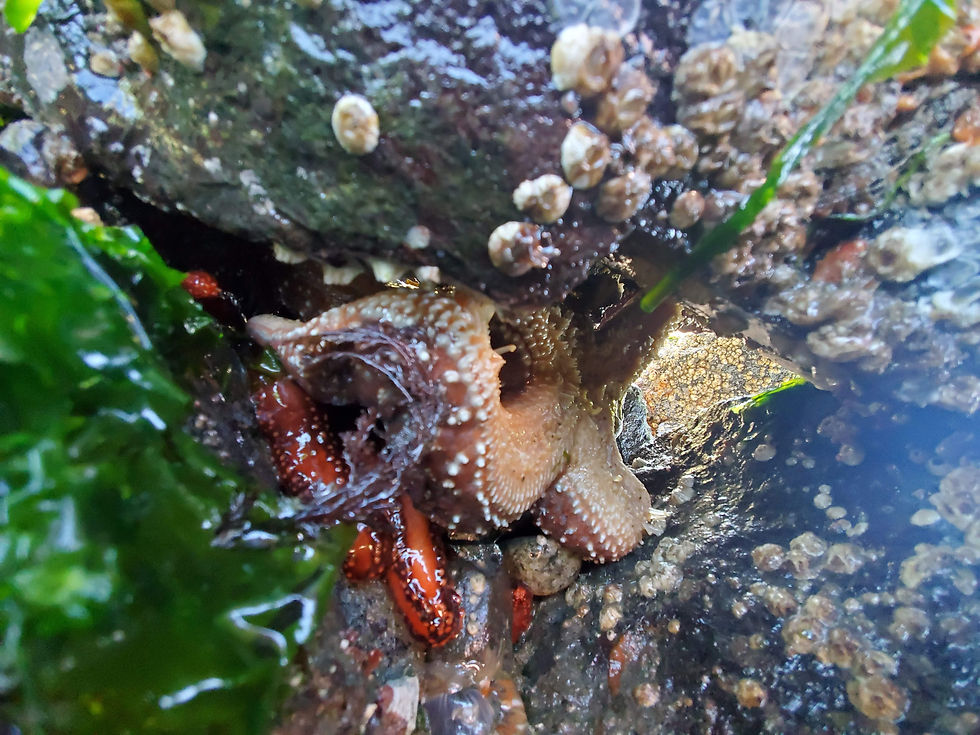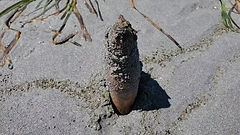
Discovery Park is the crown jewel of Seattle Parks. Its territory includes land that was important to the native ancestors of the Suquamish, Duwamish, Muckleshoot and Tulalip nations. There is evidence that up until end of the last glacial period, for almost 10,000 years, people have used this land for trade, gathering resources, meeting and preparing food. It is a very special place.
An optimal low-tide route starts at the North Beach, about a thirty minute walk from the north parking lot. You'll want to get here at least an hour before the lowest tide. From here you can make your way south, around West Point Lighthouse, all the way to the Magnolia Bluffs.
There are a few notable features on this route. About halfway between North Beach and the lighthouse there is a patch of rocks entrenched in seaweed. There is much to be explored here! Stay towards the edges of this system- the interior is quite slick and you are at high risk of stepping on someone. As you round the point at the lighthouse, significant sandbars develop. These are quire interesting, especially where the water is trapped. Keep going and you will get back to boulder territory where additional hidden treasures await.
Pacific Geoduck
Geoduck of all shapes and sizes are abundant at Discovery Park during the lowest of tides (typically anything below -2). Look for their siphons protruding from the sands closer to the water's edge. Often times all you will see of the geoduck is a little tuft of vegetable matter upon the sand. However, you may encounter geoduck in various stages of extension. If you don't startle them, you may catch them sticking up a good few inches from the sand. Show some respect for these creatures that can live up to 160 years! You may touch but be gentle.

Pacific Geoduck

Pacific Geoduck

Pacific Geoduck

Pacific Geoduck
Anemones
Aggregating anemones are absolutely everywhere at Discovery Park. Colonies appear in the sand and on rocks. It is almost impossible not to step on them but try your best not to! Larger painted anemones may also be found but are far less frequent. These are typically in rock crevices or dangling from rocks.

Aggregating Anemone

Aggregating Anemone predating on crab.

Moonglow Anemone

Aggregating Anemone
Ochre Stars
You will find the majority of ochre stars in the rocky cluster between the North Beach and the lighthouse. Most of the ochre stars at Discovery Park are a rich purple. Look for them in between the rocks.

Ochre Sea Star

Ochre Sea Star

Ochre Sea Star & Anemone

Ochre Sea Star
Red Sea Cucumber
There is an abundance of red sea cucumber in the rocky cluster between the lighthouse and the North Beach. Sometimes you'll just see their tentacles but there are plenty of whole organisms on display. Look for them in every nook and cranny.

Red sea cucumber

Red sea cucumber

Red sea cucumber

Red sea cucumber
Jellyfish
While jellyfish are not tide pool animals per se they may often be encountered during a low tide walk. Frequently they are dead, victims of the rapidly descending water. Be wary as they are still quite capable of a nasty sting. The two species I have encountered at Discovery Park are the lion's mane jellyfish and an aequorea victoria jellyfish. Even though I didn't touch any visible parts of the lion's mane it still managed to give a nasty sting.

Lion's Mane Jellyfish

Crystal jelly

Lion's Mane Jellyfish
Chiton
As with most beaches in Puget Sound, chiton are abundant. Look for these mollusks on any rocky surface. They are often camouflaged with seaweed and barnacles.

Chiton

Chiton

Chiton
Mottled Stars
Mottled stars are less common than ochre stars at Discovery Park. Unlike ochre stars, these will often be found laying in the sand. Typically they have more slender arms than ochre stars and a smaller central disk.

Mottled Star

Mottled Star

Mottled Star

Mottled Star
Lewis' Moon Snail
Timing is everything if you want to see a Lewis' moon snail. They don't tend to spend much time on the surface. You may only see part of them protruding from the sand, either a bit of shell or part of their mantle. They are not especially common to find at Discovery Park, but there is ample evidence that a sizable population inhabits this area.

Neverita lewisii

Neverita lewisii

Neverita lewisii

Oddly shaped geoduck clam popping out
Geoduck clam protruding from the sand

Yet another emergent geoduck


Red sea cucumber thinks twice about extending tentacles

Thick-horned nudibranch in moon snail egg casing
Red cucumber's failed extension attempt

LOCATION
There is no parking except by special permit at the Discovery Park beach. Fortunately every trail down is delightful, just pick any heading west and down to the water. As long as you don't venture to far north or south of the boarders of the park you won't need to watch the tide too closely, just be aware. The best sandbars can be found just south of the lighthouse, in a more popular area. There is an excellent rock patch to explore north of the lighthouse, heading towards the North Beach. There are additional large rocks to poke around just a bit further south of the sand bars.




